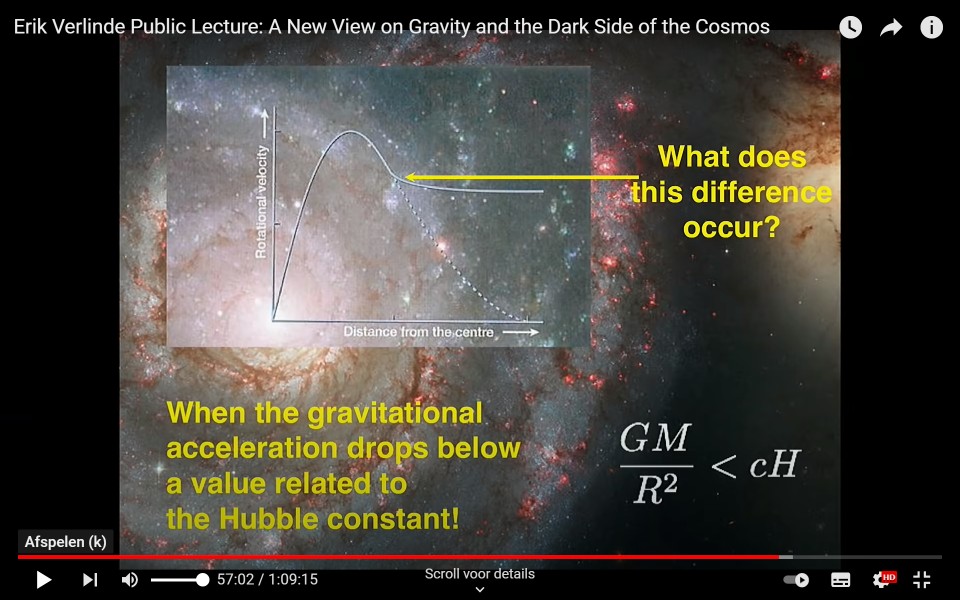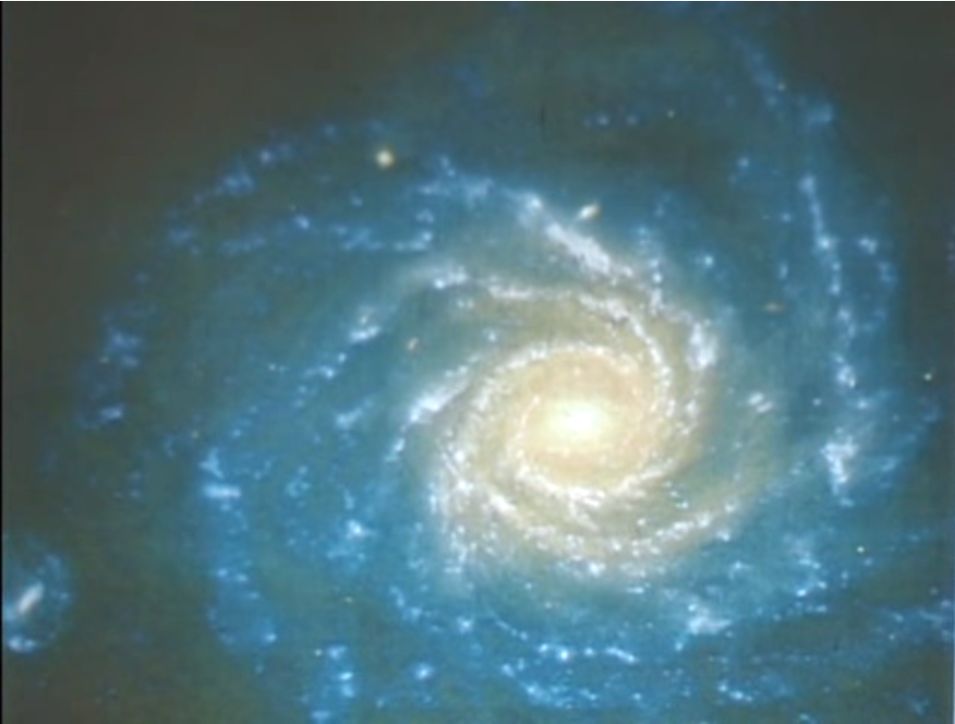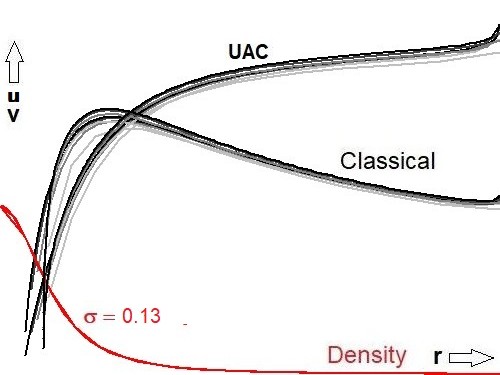
Let's present a little appetizer before we start. Quite unexpectedly, the story below is somehow motivated by an Erik Verlinde Public Lecture: A New View on Gravity and the Dark Side of the Cosmos. At timestamp 56:56 / 1:09:15 an interesting formula is displayed at the slides screen:

Translated into our own terms we infer: $$ \frac{GM}{R^2} \lt cH \hieruit \mbox{number} = \sqrt{\frac{G.W}{c_0H_0}}/L \lt 1 $$ Let's calculate that dimensionless number (with Maple 8). It turns out that it is very near to unity:
# 1 megaParsec
Mpc := 3.08567758*10^22;
# Hubble constant (2022-02-08)
hubble := 73.4*1000/Mpc;
# Gravity constant (G)
G := 6.67408*10^(-11);
# Speed of light
light := 299792458;
# Number of seconds in a year
year := 31556926;
# Radius of milky way (L)
radius := 52850*light*year;
# Mass of our sun
sun := 1.989*10^(30);
# Mass of milky way (W)
mass := 1.5*10^(12)*sun;
# According to Erik Verlinde
number := sqrt(G*mass/(light*hubble))/radius;
number := 1.056854571
Out of sheer curiosity:
light*hubble;
-9
0.7131259132 10
Which is quite close to the Pioneer anomaly:
an extremely small acceleration towards the Sun, of $\,(8.74 \pm 1.33)\times 10^{-10}\;m/s^2\,$.In view of more recent developments, made explicit in the Origin of Inertia section of UAC, a newly found formula for the Hubble parameter will be distorted as follows. $$ H = \sqrt{\chi\,G\,\rho_0} \MET \chi = \frac{4\pi}{3} $$ and $\rho_0=$ mass density. Let us assume that the galaxy is an ellipsoid, a prolate spheroid to be precise. It's main axes are $\,R\,$,$\,R\,$ and the "radius of the universe" $= c/H\,$. Then we have, in Erik Verlinde's original notation: $$ H^2 = \frac{4\pi}{3} G\,\rho_0 \MET \rho_0 = \frac{M}{4/3.\pi.R^2.c/H} \hieruit \frac{GM}{R^2} = cH $$ Near the bottom of page 1203 in The Case for a Hierarchical Cosmology we read about the old concept that nebulae are "island universes".
More about Erik Verlinde's work is found in Wikipedia: Entropic_gravity.

An active galactic nucleus (AGN) is a compact region at the center of a galaxy that has a much-higher-than-normal luminosity over at least some portion of the electromagnetic spectrum with characteristics indicating that the luminosity is not produced by stars. The Wikipedia webpage about Non-standard_cosmology says the following at the end of the linked section. Halton Arp has proposed an explanation for his observations by a Machian "variable mass hypothesis". The variable-mass theory invokes constant matter creation from active galactic nuclei, which puts it into the class of steady-state theories. With the passing of Halton Arp, this cosmology has been relegated to a dismissed theory. Dismissed? At Halton C. Arp - The Official Website. Articles we find A Symposium on Active Galactic Nuclei - One Astronomer's View. The article speaks for itself.
Let the velocity in atomic time $t$ be the desired end-result, then without Halton Arp's Theory nothing
will happen. But if varying elementary particle rest mass is involved, then according to
UAC, things are different.
So a reasonable question is: have we been overlooking something? Yes we have! We have been
mislead by an uttering from de Sitter as has been quoted in
Milne's Formula: There is nothing in our experience of
the physical world that would enable us to distinguish between the times $\,t\,$ and $\,T\,$. This statement shall
be proven wrong all over the place.
Let $\vec{s}$ be the position vector, $\vec{u}$ be the velocity with atomic time
(t) and $\vec{v}$ be the velocity with orbital time (T), then we have, according to the laws of
Time Dilation:
$$
\vec{u} = \frac{d\vec{s}}{dt} = \frac{d\vec{s}}{dT}\frac{dT}{dt} = \vec{v} \frac{\sqrt{m_0/m}}{m_0/m} = \vec{v} \sqrt{m/m_0}
$$
If elementary particle rest mass is varying across the galaxy, then the above correction should be applied to
the calculated velocities, in order to represent the observed velocities. Let us assume for a while that elementary particle rest
mass is indeed varying across the galaxy, in such a way that new mass is created in the center and becomes more aged
when spiralling in outward direction.
As a first attempt to mimick the true Galaxy rotation curve,
the following hypothesis has been tried: elementary particle rest mass is proportional to the distance from the
center of the galaxy. Formally: $m \sim r$; simply a linear relationship to begin with.
Furthermore remember that all of our calculations are dimensionless. Then we finally have:
$$
\vec{u} = \sqrt{r}\;\vec{v} \hieruit u = \sqrt{r\;v^2} = \sqrt{r}\;v
$$
Where $\vec{u}$ is the velocity with atomic time (t), $\vec{v}$ be the velocity with orbital time (T), $(u,v)$ are the absolute
values - named speed - of $(\vec{u},\vec{v})$ and $r$ is the dimensionless distance to the
nucleus.
In common speech it reads:
$$
\mbox{correct rotation curve} \sim \sqrt{\mbox{distance to nucleus}} \times \mbox{wrong rotation curve}
$$
Further motivation for our additional hypothesis comes from Modified Newtonian dynamics, especially the formulas for the deep-MOND regime ($a \ll a_0$):
$$
{\displaystyle F_{\text{N}}=m{\frac {\,a^{2}\,}{\,a_{0}\,}}~.}
$$
Applying this to an object of mass $\,m\,$ in circular orbit around a point mass $\,M\,$ (a crude approximation for a star in the outer
regions of a galaxy), we find:
$$
{\displaystyle {\frac {\,GMm\,}{r^{2}}}=m{\frac {\;\left({\frac {\,v^{2}\,}{r}}\right)^{2}\;}{a_{0}}}
\quad \Longrightarrow \quad v^{4}=GMa_{0}~,}
$$
that is, the star's rotation velocity is independent of $\,r\,$, its distance from the centre of the galaxy - the rotation curve is flat,
as required.
In comparison we have, with UAC, for the same crude approximation, that the rotation curve
is flat as required, but with a square instead of a fourth power and no free parameter $\,a_0\,$:
$$
\frac{GMm}{r^2} = m\frac{v^2}{r} \hieruit v = \sqrt{\frac{GM}{r}} \\
u = \sqrt{r/R}\;v \hieruit u^2 = \frac{GM}{R}
$$
Where our dimensionless $\,0 \le r \le 1\,$ is replaced by the real world one, by multiplying it with the galaxy's radius $\,R\,$.
Just for fun, let us try to calculate Mordehai Milgrom's factor $\,a_0\,$:
$$
\left(u^2\right)^2 \; (\mbox{UAC}) = v^4 \; (\mbox{MOND}) \hieruit \left(\frac{GM}{R}\right)^2 = GM\,a_0
\hieruit \\ a_0 = \frac{GM}{R^2}
$$
Milgrom's constant - as it appears in UAC - is equal to the standard gravitational parameter divided by the radius squared of a galaxy.
The quantities $\,GM\,$ and $\,R\,$ have been determined before, so we just have to continue a previous calculation (see above):
a_0 := G*mass/radius^2;
-9
a_0 := 0.7965199875 10
So we have $\,a_0 \approx 8.0 \times 10^{-10}\mathrm {ms} ^{-2}\,$, while
Milgrom found ${\displaystyle \,a_{0}\approx 1.2\times 10^{-10}\mathrm {ms} ^{-2}\,}$ to be optimal.
In the original MOND theory the free parameter $\,a_0\,$ is conceived as being a constant
and our equality $\,a_0=GM/R^2\,$ is replaced by inequalities.
It is perhaps (not) relevant to notice that $\,a_0\,$ is of the same order of magnitude as the (also previously calculated)
Pioneer anomaly $\approx c_0 H_0\,$. And it's not a great miracle
that this fact has been observed in true MOND theory as well: take a look
at formula (2) in the PDF. Perhaps the Pioneer anomaly subsection in Origin of Inertia
is interesting too.
Our end result has been obtained by adapting too the value of the width $\sigma =$ Sigma
of the mass density distribution: $\sigma = 0.10 \to \sigma = 0.13$. Let's repeat what's all about.
A reference is this one,
on page 19:
$$
\rho(R) = C\,\left[1+(R/\sigma)^2\right]^{-3/2} \MET 0 \le R \le 1 \quad
\mbox{and} \quad \sigma = 0.13
$$
So there is scaling factor ($1/C$) involved, namely the one that norms the mass of the galaxy to unity, according to
$\int_0^1 \rho(R)\cdot2\pi R\,dR = 1$. By hand we calculate:
$$
C = \int_0^1 \left[1+(R/\sigma)^2\right]^{-3/2}\cdot 2\pi R\,dR =
\pi\sigma^2 \int_0^1 \left[1+(R/\sigma)^2\right]^{-3/2} d\left[1+(R/\sigma)^2\right] = \\
\pi\sigma^2 \int_1^{1+1/\sigma^2} y^{-3/2} dy = -2\pi\sigma^2 \left[y^{-1/2}\right]_1^{1+1/\sigma^2} =
2\pi\sigma^2 \left[1 - \frac{1}{\sqrt{1+1/\sigma^2}}\right] = \\
2\pi\sigma^2 \frac{\sqrt{1+1/\sigma^2}-1}{\sqrt{1+1/\sigma^2}}\frac{\sqrt{1+1/\sigma^2}+1}{\sqrt{1+1/\sigma^2}+1} =
\frac{2\pi}{\sqrt{1+1/\sigma^2}\left[1+\sqrt{1+1/\sigma^2}\right]}
$$
Giving at last:
$$
\rho(R) = \frac{1}{C}\,\left[1+(R/\sigma)^2\right]^{-3/2}
\MET C = \frac{2\pi}{\sqrt{1+1/\sigma^2}+(1+1/\sigma^2)}
$$
One reason why the result is repeated here is that there may be an error in the scaling factor $C$ with a previous - and
herewith declared deprecated - implementation of our app.
A further complication is that there is another scaling factor now for the UAC result, due to the fact that according to our model
all elementary particle rest mass is assumed to increase in a linear fashion from the center to the outer boundary of the galaxy.
As a consequence the total mass (= integral) would be too small, which of course has to be corrected.
This means that we have to evaluate the following integral as well:
$$
F = \int_0^1 \left[1+(R/\sigma)^2\right]^{-3/2}\,R\,2\pi R\,dR
$$
What we shall finally have is a scaling factor $\,1/C\,$ for the classical Newtonian result and a different scaling factor $\,1/F\,$
for the UAC result. It's too difficult to calculate $\,F\,$ by hand,
therefore a computer algebra system (Maple 8) is asked for help:
> p(R) := (1+(R/sigma)^2)^(-3/2);
> c := 2*Pi*int(p(R)*R,R=0..1);
> f := 2*Pi*int(p(R)*R^2,R=0..1);
> C := evalf(subs(sigma=0.13,c));
C := 0.09249686077
> F := evalf(subs(sigma=0.13,f));ere
F := 0.02410082965
> gok := (1/F)/(1/C);
gok := 3.837911894
The additional scaling factor gok for $\,u^2\,$ with UAC is $\approx 4\,$
times the one for the Classical $\,v^2\,$, hence the square root of it ($\approx 2$) shall be visible
as a scaling factor in the end result.

.jpg)
The Source Code of the (thus modified) app shall be in the public domain; search for "Unified Alternative Cosmology" in the source.
Louis Marmet via A Cosmology Group (2023 Feb 17): That was in response to many papers published at the time saying that 'flat' rotation curves show that the luminous mass is much less than the gravitational mass. This is false, it's the fast 300 km/s rotation that needs more gravity, not the flat curves. Real velocities can be estimated from the above leftmost picture. The original size of it has been:
xmin := 0; xmax := 1; ymin := 0; ymax := 2;And the UAC velocity profile is at approximately 200 out of 500 pixels from the top.
# As defined in the Source Code: speed : double = 250000; # As learned from the picture: (500-200)/500*2*V = 300,000 m/sThus leading indeed to the required "fast 300 km/s rotation" (a bit by coincidence admittedly :-)